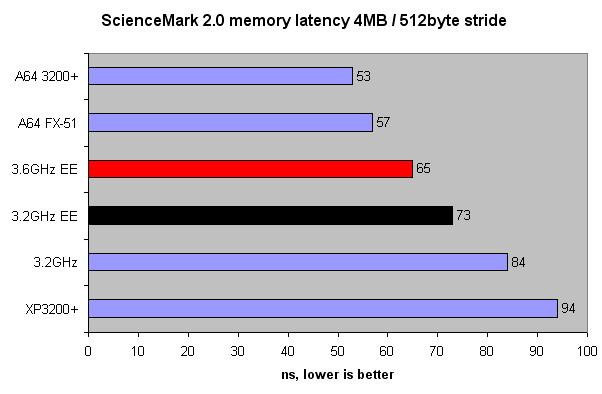Memory benchmarks
ScienceMark 2.0 provides comprehensive bandwidth and latency analysis. It's these two factors that will help the E.E to differentiate itself from the run-of-the-mill, if you can call it that, 3.2GHz Northwood. The E.E was also tested at 3.6GHz / 200FSB.

Measuring memory bandwidth necessitates testing out of cache, and there's plenty of it on the Extreme Edition. It seems to be very slightly faster than the regular 3.2GHz and some way behind the impressive Athlon 64 FX-51.

Latency is perhaps the more important factor with respect to performance. Again, a 4MB data chunk is tested to stop the E.E's cache from influencing results. It appears to be faster than the incumbent P4, and faster still with a higher clock speed. Nothing can touch the on-die Athlon 64s, however. Remember that the motherboard was the same for both the E.E and regular 3.2GHz CPU.
I was going to include a spiffy graph highlighting how the E.E's L3 cache runs at a higher latency when compared to L1 and L2, but is far lower than main memory's. Instead, a cut and paste will have to suffice.
Firstly, the E.E at 3.2GHz.

And now the regular 3.2GHz CPU.

The block size is shown in the first column and the byte stride in the first row. What's important to recognise is the 1MB - 2MB range. This is where the Extreme Edition's Level 3 cache resides. Using a byte stride of larger than 32 shows increasing differences, and using a 512byte stride and 1MB block size on the Extreme Edition results in a latency of 39 clocks, which if you convert back into nanoseconds (latency / clock speed) gives you roughly 12ns. Compare that with the 82ns for the regular 3.2GHz CPU. Lower latencies afford faster CPU access, which should result in increased performance in memory-intensive tasks with large data sets.
Also note just how fast the Pentium 4's Level 1 cache is. It may not be exceedingly large, but it's hugely quick.









